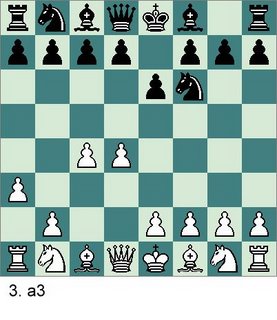This game is technically a miniature, lasting only 20 moves. This game also demonstrates why you should know a little opening theory. I have White.
1.d4 Nf6
2.c4 e6
3.a3
 He or She is trying to play the Nimzo Indian and I wasn't really in the mood for having my knight pinned and just pushed a3 instead. This move is ok, but it gives up some time. I have taken this game out of book and he apparently doesn't know how to handle it.
He or She is trying to play the Nimzo Indian and I wasn't really in the mood for having my knight pinned and just pushed a3 instead. This move is ok, but it gives up some time. I have taken this game out of book and he apparently doesn't know how to handle it.3. ... c5
He is trying to challenge me for the center.
4.d5
My intention is to hold a pawn in the center.
4. ... exd5
5.cxd5 b6
He wants to develop his bishop to attack my pawn, I believe, I can protect this pawn with developing moves.
6.Nc3 Bb7
7.e4 Be7
 I have a key position now. My pawns are safe. Whats more, now that I have 2 pieces protecting my d5 pawn (Queen and Knight,) I can safely push my e4 pawn that was protecting my d5 pawn and attack his knight. His knight only choice is to retreat back to its home position. He wanted to castle and now I have forced him to undevelop. Instead of Be7, he should have moved d6 preventing my over running him.
I have a key position now. My pawns are safe. Whats more, now that I have 2 pieces protecting my d5 pawn (Queen and Knight,) I can safely push my e4 pawn that was protecting my d5 pawn and attack his knight. His knight only choice is to retreat back to its home position. He wanted to castle and now I have forced him to undevelop. Instead of Be7, he should have moved d6 preventing my over running him.8.e5 Ng8
9.d6
Another sharp move, attacking his bishop.
9. ... Bf8
Another undeveloping move, Bishop to g5 was better. He is now very constricted.
10.Nf3 Nc6
11.Bf4 f6
He wants to trade and possible break up my repressive center. As long as I can maintain my center I can keep him from castling. I just have a temporary advantage. By moving his f7 pawn he is taking a huge risk, since f2/f7 is a key protection for the king cage (if he can ever get castled.)

I almost panicked with this move. I was so focused on attack, I wasn't paying attention to defense. But in truth I am perfectly fine. My Bd5 is ok, but I should really have considered Qe2.
(15. Qe2 threating a very ugly Bf6+ which looses the black queen and 1 minor piece to my ugly d6 pawn.)
15.Bd5 Bxd5
16.Qxd5 Rd8
17.0-0
 Note castling is both a defensive and an offensive move. I want to put a rook on e1 to finish my oppoent off and the quickest way was to castle, and its such an unoffensive looking move.
Note castling is both a defensive and an offensive move. I want to put a rook on e1 to finish my oppoent off and the quickest way was to castle, and its such an unoffensive looking move.17. ... Nf6
A final feeble attempt to get back in the game.
18.Bxf6 Qxf6
19.Rfe1+ Be7
Be7 is forced in order get out of check.
20.Rxe7+ Black resigns







